engine KIA BORREGO 2017 Owner's Guide
[x] Cancel search | Manufacturer: KIA, Model Year: 2017, Model line: BORREGO, Model: KIA BORREGO 2017Pages: 548, PDF Size: 36.78 MB
Page 128 of 548

439
Features of your vehicle
Power steering
Power steering uses energy from the
engine to assist you in steering the
vehicle. If the engine is off or if the
power steering system becomes
inoperative, the vehicle may still be
steered, but it will require increased
steering effort.
Should you notice any change in the
effort required to steer during normal
vehicle operation, we recommend
that the system be checked by an
authorized Kia dealer.Ō£ĮŌ£ĮNOTICE
If the power steering drive belt
breaks or if the power steering
pump malfunctions, the steering
effort will greatly increase.
Ō£Į
Ō£Į NOTICE
If the vehicle is parked for extended
periods o utside in cold weather (below
-10┬░C(14┬░F)), the power steering may
require increased effort when the
engine is first started. This is caused by
increased fluid viscosity due to the cold
weather and does not indicate a mal-
function.
When this happens, increase the
engine RPM by depressing the accel-
erator until the RPM reaches 1,500
rpm then release or let the engine idle
for two or three minutes to warm up
the fluid.
Tilt steering
Tilt steering allows you to adjust the
steering wheel before you drive. You
can also raise it to give your legs
more room when you exit and enter
the vehicle.
The steering wheel should be posi-
tioned so that it is comfortable for
you to drive, while permitting you to
see the instrument panel warning
lights and gauges.
STEERING WHEEL
CAUTION
Never hold the steering wheel to
the extreme right or left for morethan 5 seconds with the engine running. Holding the steeringwheel for more than 5 secondsin either position may cause damage to the power steeringpump.
WARNING
Never adjust the angle of the steering wheel while driving.
You may lose steering control
and cause severe personal
injury, death or accidents.
After adjusting, push the steering wheel both up and
down to be certain it is lockedin position.
Page 131 of 548
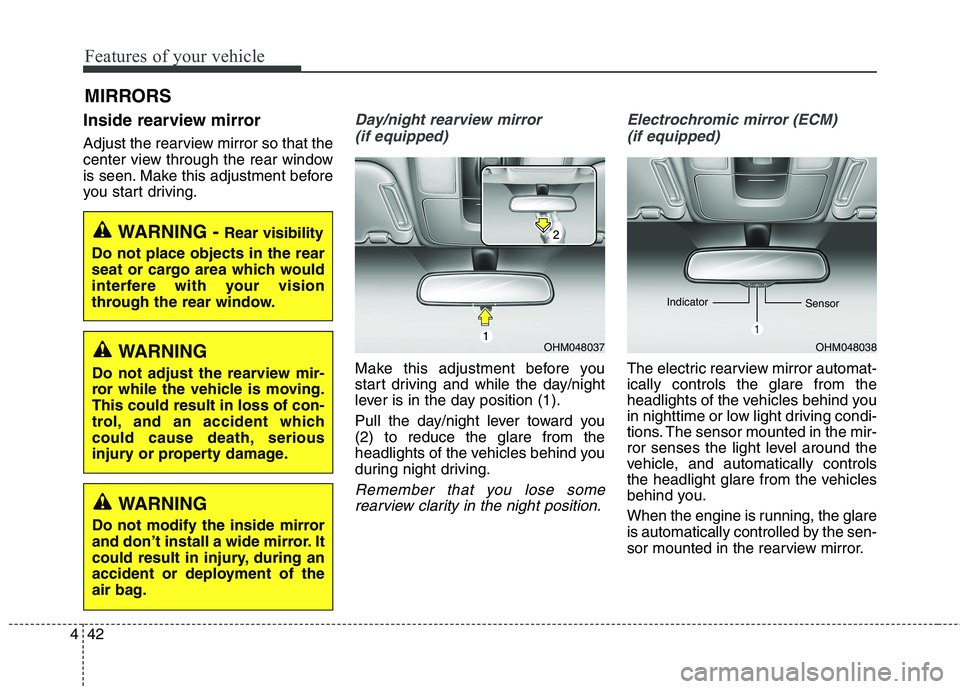
Features of your vehicle
42
4
Inside rearview mirror
Adjust the rearview mirror so that the
center view through the rear window
is seen. Make this adjustment before
you start driving.Day/night rearview mirror
(if equipped)
Make this adjustment before you
start driving and while the day/night
lever is in the day position (1).
Pull the day/night lever toward you (2) to reduce the glare from the
headlights of the vehicles behind you
during night driving.
Remember that you lose somerearview clarity in the night position.
Electrochromic mirror (ECM)
(if equipped)
The electric rearview mirror automat- ically controls the glare from the
headlights of the vehicles behind you
in nighttime or low light driving condi-
tions. The sensor mounted in the mir-
ror senses the light level around the
vehicle, and automatically controls
the headlight glare from the vehicles
behind you.
When the engine is running, the glare
is automatically controlled by the sen-
sor mounted in the rearview mirror.
MIRRORS
WARNING -
Rear visibility
Do not place objects in the rear
seat or cargo area which would
interfere with your vision
through the rear window.
OHM048037WARNING
Do not adjust the rearview mir-
ror while the vehicle is moving.This could result in loss of con-
trol, and an accident which
could cause death, serious
injury or property damage.
WARNING
Do not modify the inside mirror
and donŌĆÖt install a wide mirror. It
could result in injury, during an
accident or deployment of the
air bag.
OHM048038
Indicator
Sensor
Page 135 of 548
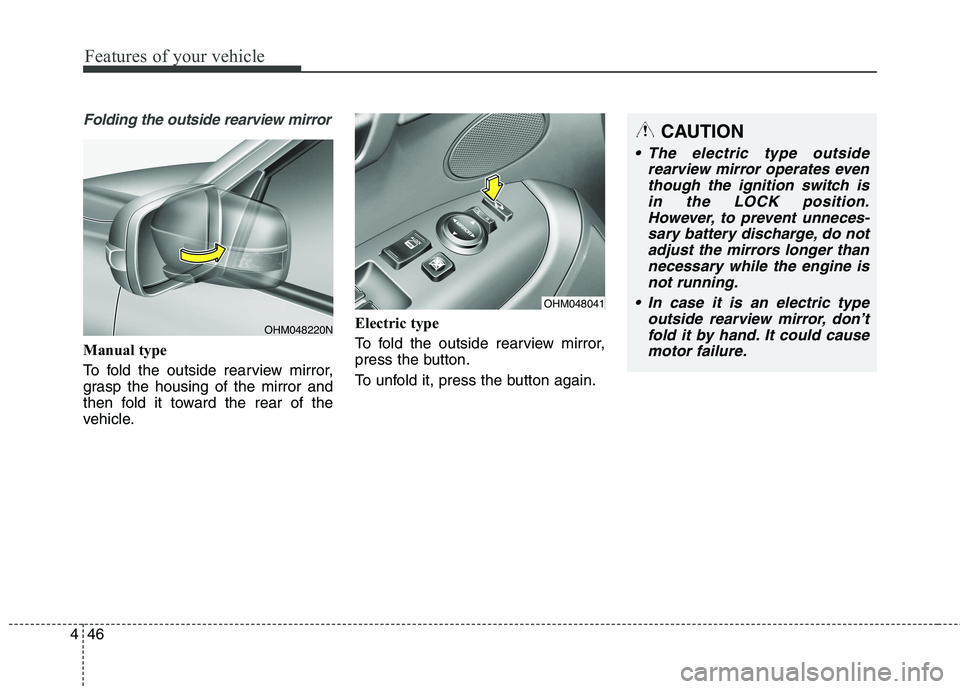
Features of your vehicle
46
4
Folding the outside rearview mirror
Manual type
To fold the outside rearview mirror,
grasp the housing of the mirror and
then fold it toward the rear of the
vehicle. Electric type
To fold the outside rearview mirror,
press the button.
To unfold it, press the button again.
OHM048041
CAUTION
The electric type outside
rearview mirror operates eventhough the ignition switch is in the LOCK position.However, to prevent unneces-sary battery discharge, do not adjust the mirrors longer thannecessary while the engine isnot running.
In case it is an electric type outside rearview mirror, donŌĆÖtfold it by hand. It could causemotor failure.
OHM048220N
Page 136 of 548
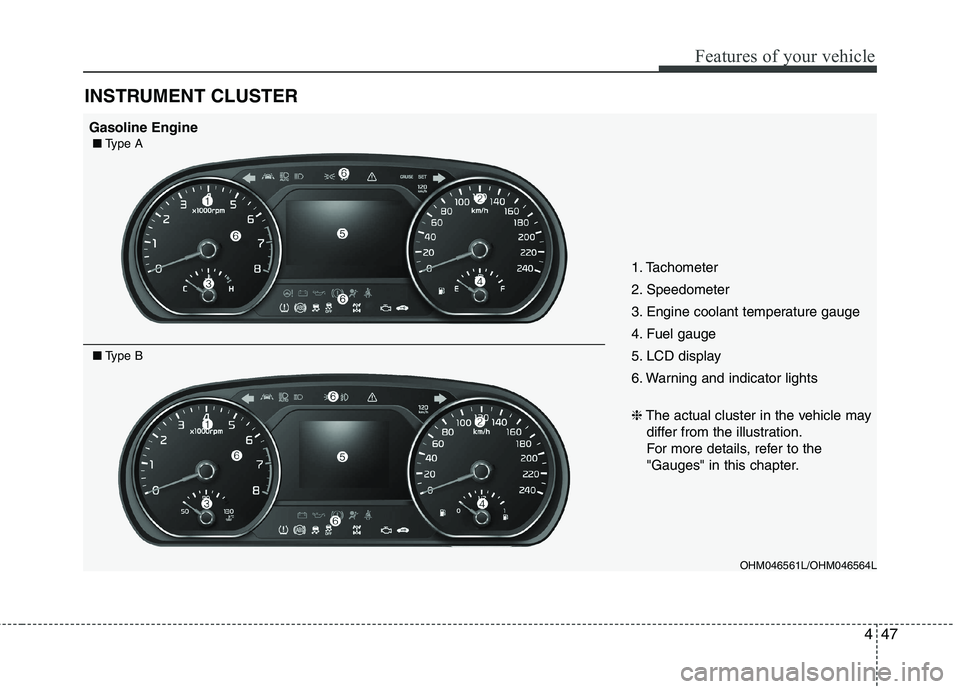
447
Features of your vehicle
INSTRUMENT CLUSTER
OHM046561L/OHM046564L
1. Tachometer
2. Speedometer
3. Engine coolant temperature gauge
4. Fuel gauge
5. LCD display
6. Warning and indicator lights ŌØł
The actual cluster in the vehicle may
differ from the illustration.
For more details, refer to the
"Gauges" in this chapter.
Gasoline Engine Ō¢Ā Type A
Ō¢ĀType B
Page 137 of 548
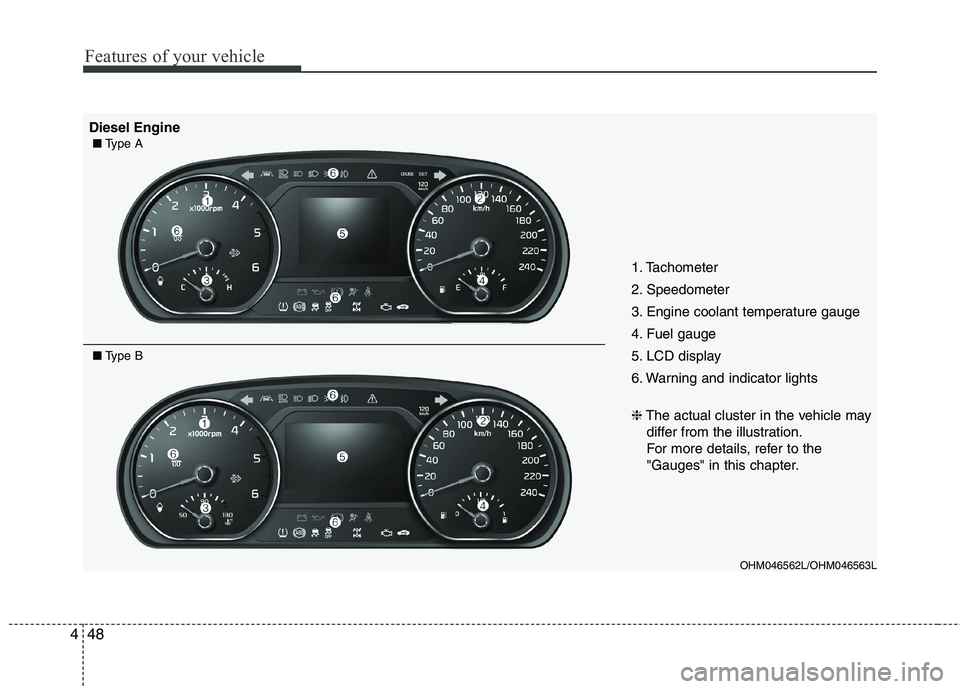
Features of your vehicle
48
4
OHM046562L/OHM046563L
1. Tachometer
2. Speedometer
3. Engine coolant temperature gauge
4. Fuel gauge
5. LCD display
6. Warning and indicator lights ŌØł
The actual cluster in the vehicle may
differ from the illustration.
For more details, refer to the
"Gauges" in this chapter.
Diesel Engine Ō¢Ā Type A
Ō¢ĀType B
Page 138 of 548
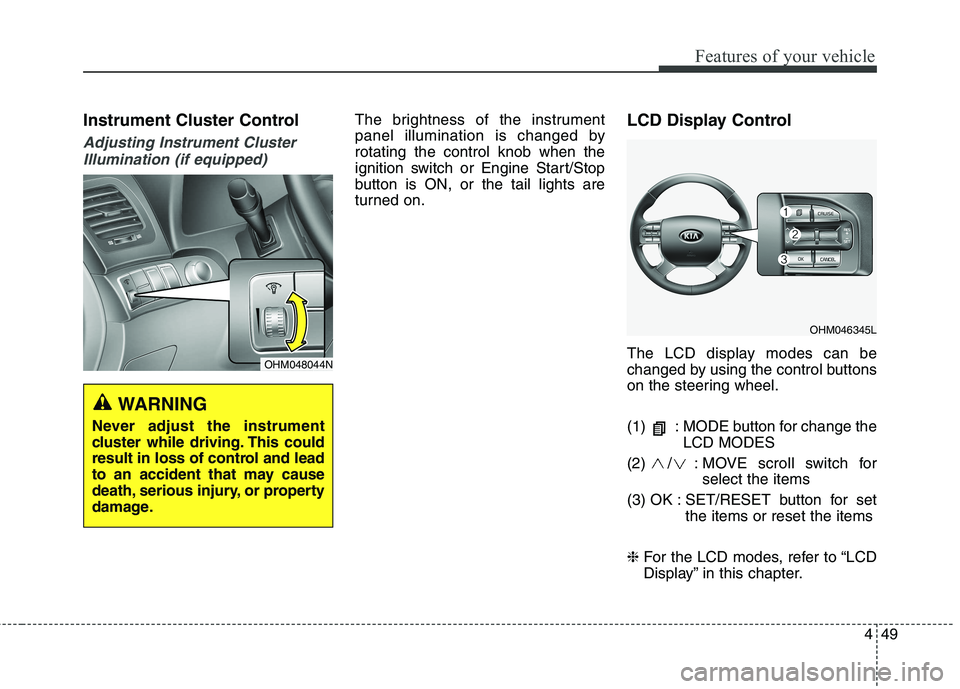
449
Features of your vehicle
Instrument Cluster Control
Adjusting Instrument ClusterIllumination (if equipped)
The brightness of the instrument
panel illumination is changed byrotating the control knob when the
ignition switch or Engine Start/Stop
button is ON, or the tail lights are
turned on. LCD Display Control
The LCD display modes can be
changed by using the control buttons
on the steering wheel.
(1) : MODE button for change the
LCD MODES
(2) / : MOVE scroll switch for select the items
(3) OK : SET/RESET button for set the items or reset the items
ŌØł For the LCD modes, refer to ŌĆ£LCD
DisplayŌĆØ in this chapter.
OHM048044N
WARNING
Never adjust the instrument
cluster while driving. This could
result in loss of control and lead
to an accident that may cause
death, serious injury, or property
damage.
OHM046345L
Page 139 of 548
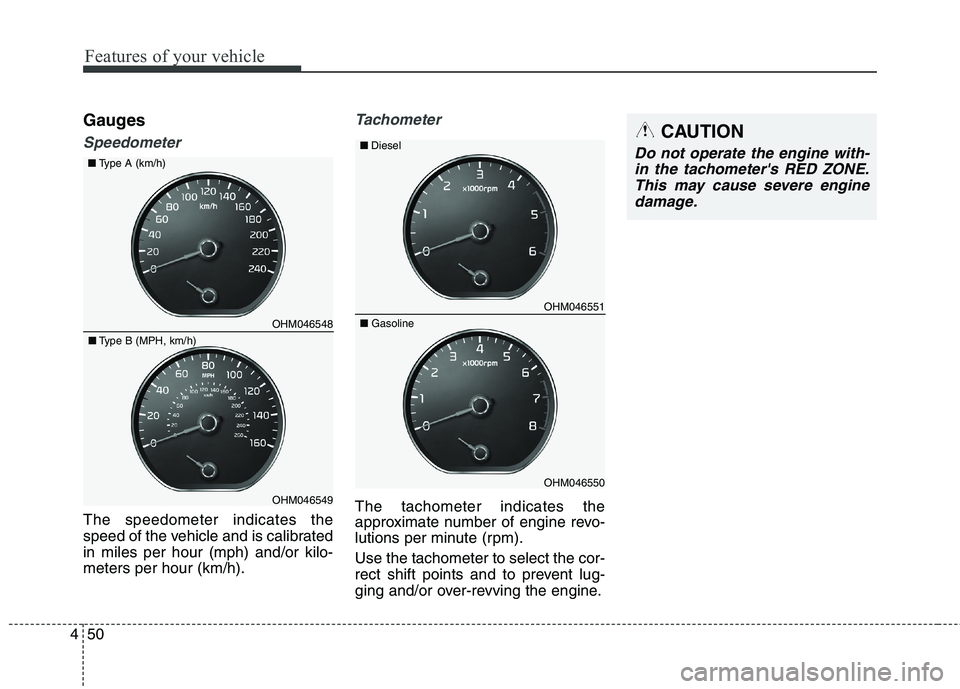
Features of your vehicle
50
4
Gauges
Speedometer
The speedometer indicates the
speed of the vehicle and is calibratedin miles per hour (mph) and/or kilo-meters per hour (km/h).
Tachometer
The tachometer indicates the
approximate number of engine revo-
lutions per minute (rpm). Use the tachometer to select the cor-
rect shift points and to prevent lug-
ging and/or over-revving the engine.
OHM046548
OHM046549
Ō¢Ā
Type B (MPH, km/h)
Ō¢Ā Type A (km/h)
OHM046551
OHM046550
Ō¢Ā
Gasoline
Ō¢Ā DieselCAUTION
Do not operate the engine with-
in the tachometer's RED ZONE.This may cause severe engine damage.
Page 140 of 548
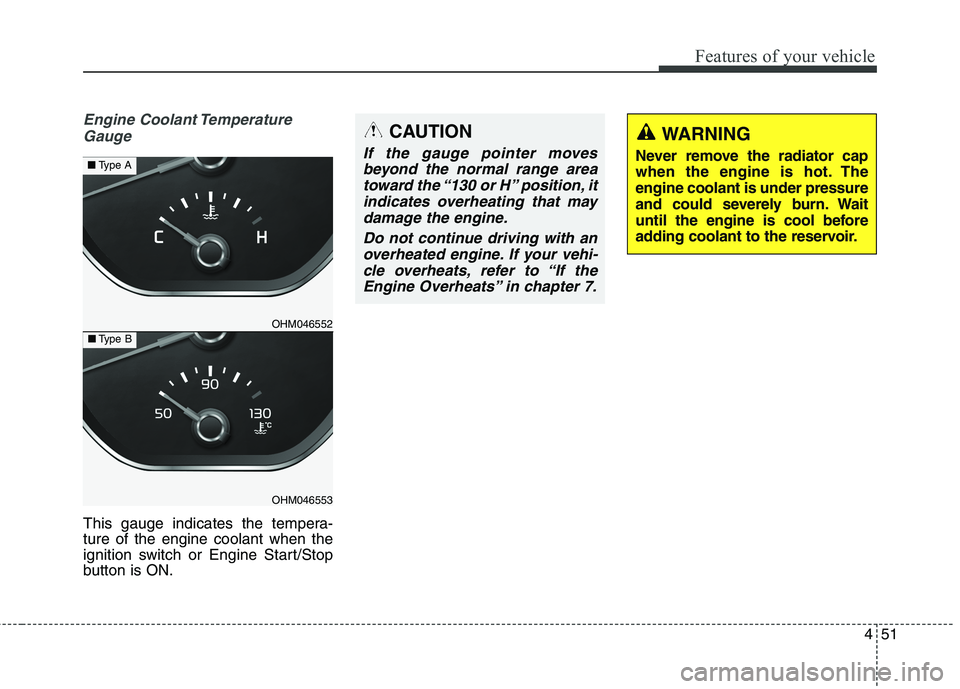
451
Features of your vehicle
Engine Coolant TemperatureGauge
This gauge indicates the tempera- ture of the engine coolant when the
ignition switch or Engine Start/Stop
button is ON.
CAUTION
If the gauge pointer movesbeyond the normal range areatoward the ŌĆ£130 or HŌĆØ position, it indicates overheating that maydamage the engine.
Do not continue driving with anoverheated engine. If your vehi-cle overheats, refer to ŌĆ£If the Engine OverheatsŌĆØ in chapter 7.
WARNING
Never remove the radiator cap
when the engine is hot. Theengine coolant is under pressure
and could severely burn. Wait
until the engine is cool before
adding coolant to the reservoir.
OHM046552
OHM046553
Ō¢Ā Type B
Ō¢ĀType A
Page 141 of 548
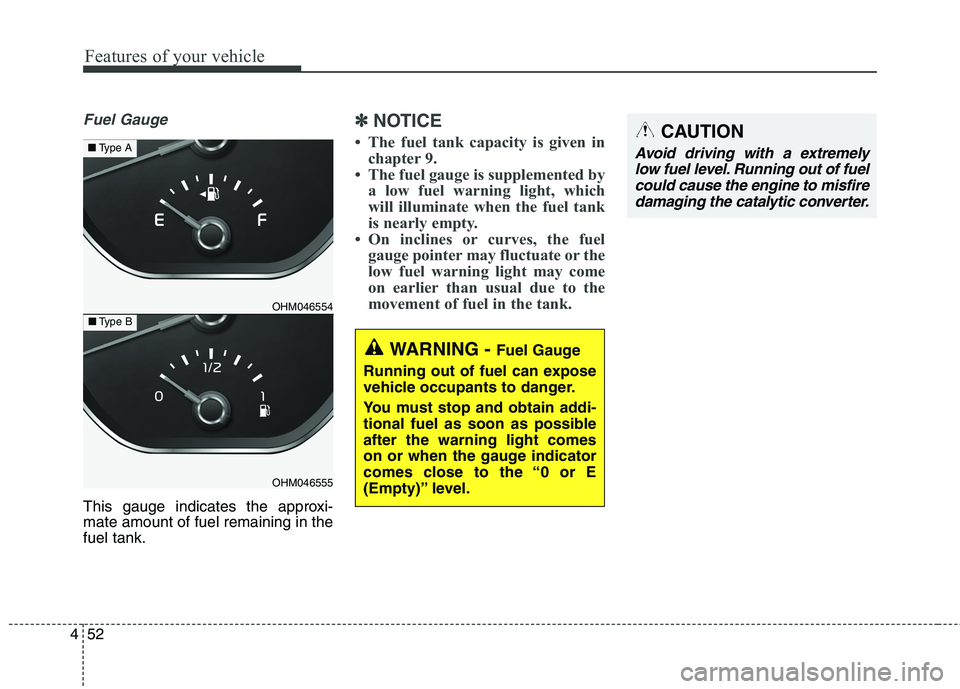
Features of your vehicle
52
4
Fuel Gauge
This gauge indicates the approxi- mate amount of fuel remaining in thefuel tank.
Ō£ĮŌ£Į
NOTICE
The fuel tank capacity is given in chapter 9.
The fuel gauge is supplemented by a low fuel warning light, which
will illuminate when the fuel tank
is nearly empty.
On inclines or curves, the fuel gauge pointer may fluctuate or the
low fuel warning light may come
on earlier than usual due to the
movement of fuel in the tank.
WARNING - Fuel Gauge
Running out of fuel can expose
vehicle occupants to danger.
You must stop and obtain addi-
tional fuel as soon as possibleafter the warning light comes
on or when the gauge indicator
comes close to the ŌĆ£0 or E
(Empty)ŌĆØ level.
CAUTION
Avoid driving with a extremely low fuel level. Running out of fuelcould cause the engine to misfiredamaging the catalytic converter.
OHM046554
OHM046555
Ō¢Ā Type B
Ō¢Ā Type A
Page 145 of 548
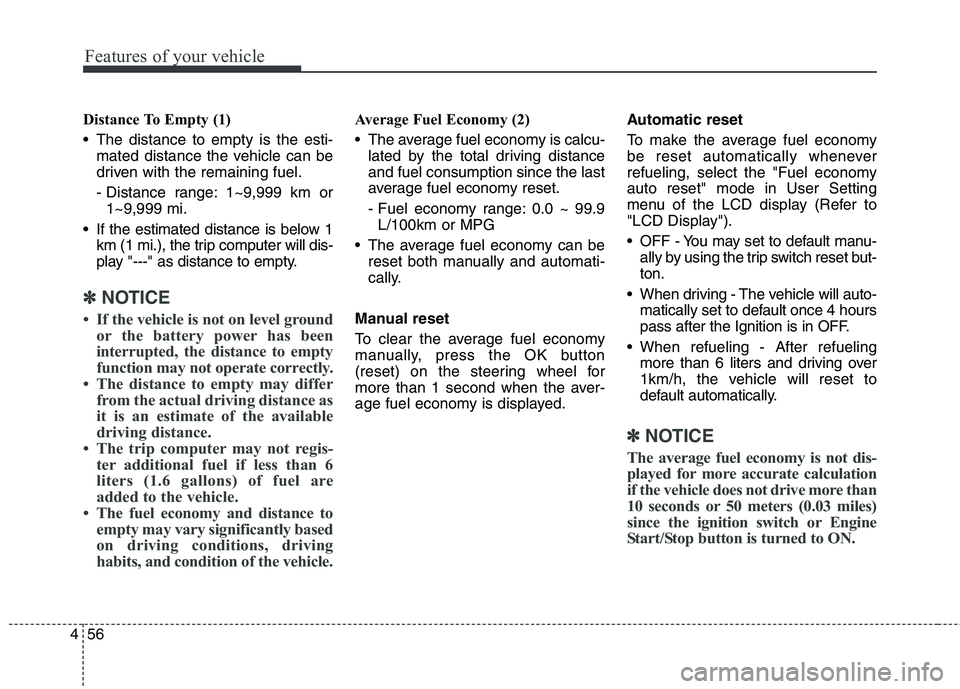
Features of your vehicle
56
4
Distance To Empty (1)
The distance to empty is the esti-
mated distance the vehicle can be
driven with the remaining fuel.
- Distance range: 1~9,999 km or1~9,999 mi.
If the estimated distance is below 1 km (1 mi.), the trip computer will dis-
play "---" as distance to empty.
Ō£ĮŌ£Į NOTICE
If the vehicle is not on level ground or the battery power has been
interrupted, the distance to empty
function may not operate correctly.
The distance to empty may differ from the actual driving distance as
it is an estimate of the available
driving distance.
The trip computer may not regis- ter additional fuel if less than 6
liters (1.6 gallons) of fuel are
added to the vehicle.
The fuel economy and distance to empty may vary significantly based
on driving conditions, driving
habits, and condition of the vehicle.
Average Fuel Economy (2)
The average fuel economy is calcu-lated by the total driving distance and fuel consumption since the last
average fuel economy reset.
- Fuel economy range: 0.0 ~ 99.9L/100km or MPG
The average fuel economy can be reset both manually and automati-
cally.
Manual reset
To clear the average fuel economy
manually, press the OK button
(reset) on the steering wheel for
more than 1 second when the aver-
age fuel economy is displayed. Automatic reset
To make the average fuel economy
be reset automatically whenever
refueling, select the "Fuel economyauto reset" mode in User Setting
menu of the LCD display (Refer to
"LCD Display").
OFF - You may set to default manu-
ally by using the trip switch reset but- ton.
When driving - The vehicle will auto- matically set to default once 4 hours
pass after the Ignition is in OFF.
When refueling - After refueling more than 6 liters and driving over
1km/h, the vehicle will reset to
default automatically.
Ō£ĮŌ£Į NOTICE
The average fuel economy is not dis-
played for more accurate calculation
if the vehicle does not drive more than
10 seconds or 50 meters (0.03 miles)
since the ignition switch or Engine
Start/Stop button is turned to ON.